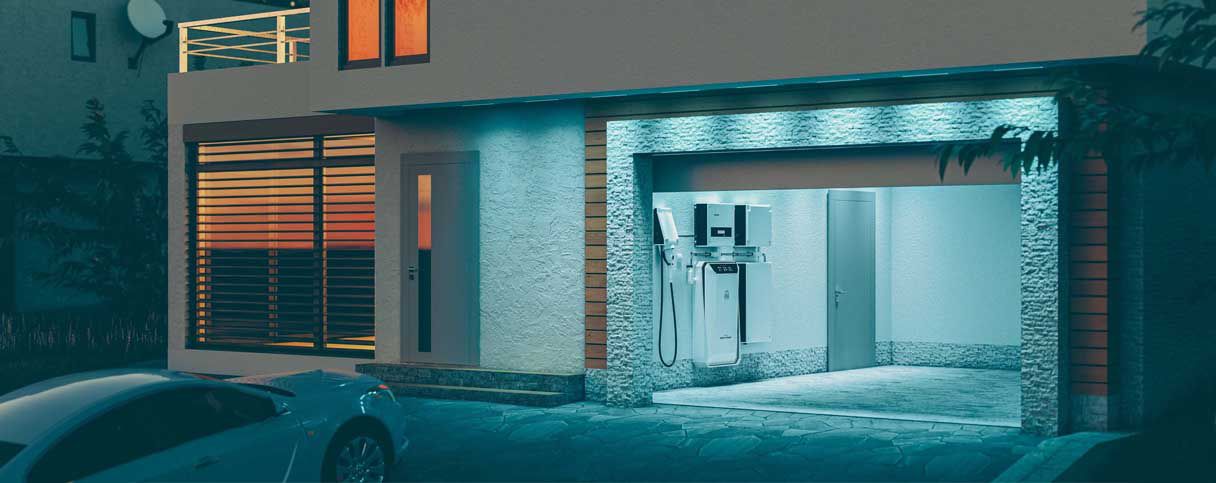
Power
Supplying power to your garage: Hints and tips on power supply
What do a grinder, a car battery charger and a radio have in common? That’s right: They need electric power. And all three of them are often used in a garage. A grinder is an essential tool for many DIY enthusiasts, while those with mechanical skills will often have a car battery charger as emergency backup. And someone who spends a fair amount of time in the garage usually likes a little background music from their radio. Moreover, owners increasingly need power in their garage to charge their electric vehicles. A close-by power socket is also useful for car care jobs, too, such as vacuuming the footwell. With no independent power supply, you'd need an extension cable to do any of that. The good news is: Most new garages incorporate power supply. For those still reliant on an older garage, however, the following question usually arises sooner or later: How can I supply power to my garage? The following article provides tips for planning.
Consult your local planning authority and talk to your neighbours
As with so many things, when it comes to supplying power in the garage: Good planning is half the battle. If you’re intending to use the garage for more than just protecting your vehicle from the elements, you should first think carefully about what you need power in the garage for, and where you’re going to be doing it. Because there's nothing more annoying than having a power socket in the wrong place, meaning you have to fall back on an extension cable anyway. But be aware: If you are intending to use the garage for other purposes on a permanent basis, you should consult the competent planning authority to ensure that what you’re doing is legal. It might also be a good idea to inform the neighbours about your plans for alternative usage, so as to avoid any disputes.
Plan electrical installation work carefully
You can then start planning out your ideas: If you’re intending to set up a DIY work area, for example, you’ll need enough sockets at that specific point to connect multiple devices simultaneously. A heavy current or three-phase connection could also be useful for this purpose. If you are planning a seating area to meet up with friends, on the other hand, you might need sockets for a music system or a fridge. And don't forget about lights. As well as basic lighting, a workshop area in particular should be equipped with one or more additional lights. You should also consider the need for pathway lighting, or spotlights in front of the garage. And maybe you’re also looking to connect up a motion detector? An electric garage door also needs power, and a separate circuit for it is essential. You might also need a key switch or a radio-operated code switch in the outdoor area. If the door is operated by remote control, linking it to the lighting can provide additional comfort and convenience. Electric vehicles have their own special demands. They need a dedicated power cable with a separate circuit and their own residual current circuit-breaker. Though vehicles can theoretically be charged from standard household power sockets, these are not designed for continuous use, and their lower power output means charging is much slower. Always have charging stations installed by a specialist contractor, so as to comply with all relevant standards and to ensure proper installation. When positioning the sockets, it may be beneficial to place them high enough to prevent damage to the paintwork of your vehicle due to scraping against them. A height of at least 1.10 metres is advisable.
Questions for your planning
The following questions can be helpful when planning power supply to your garage:
Which activities that require power are you going to be undertaking in the garage?
How many sockets will you need for the purposes, and where would they be best positioned?
How much light will you need in what areas?
Are you intending to install a surveillance camera?
Are you intending to charge an electric vehicle in the garage?
Do you need switchable and water-proof outdoor sockets for a lawn mower, hedge trimmer or the like?
Do you need to consider any retrofit elements?
Supplying power to your garage
It is essential for the garage to have its own sub-distribution board and residual current circuit breaker. Outside sockets, in particular, should be on a separate circuit, and be disconnectable from inside. This will prevent unauthorised persons from tapping into your power supply. If you already have a small power supply to the garage, such as for an overhead light, installing additional sockets will be relatively easy. It will be more complicated if you don’t. In such a case, you’ll need to route a connecting power cable from the house. That might also involve some drilling, depending on where the garage is sited on the property. Or an underground cable can be used to supply the garage with power. Always engage a professional contractor to carry out the actual installation work. You will then be sure that cables are correctly laid, and also avoid any problems with insurance or warranty cover. You can, however, save your contractor a lot of work if you have thought beforehand about what kind of power supply to the garage you want.
An exceptional scenario: Power supply to a carport
Carports are also becoming increasingly popular. If you’re intending to install a power supply to your carport, always bear in mind that it is an open and freely accessible structure. That means there is a risk that unauthorised persons might steal your electricity from any socket outlets you install. You can avoid this by using outdoor sockets with lockable covers.